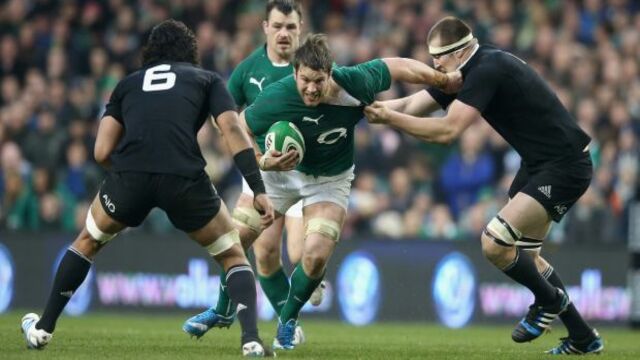The Art of Selection & the Soldier Field meltdown
The All Blacks selectors get very few things wrong. Even in the face of media clamouring, they tend to stick to their principles, and they have been proved right time and time again.
However in the Ireland’s epic victory over the All Blacks in Chicago, I believe a departure from principles cost New Zealand dear before the match ever kicked off. With their top locks, Brodie Retallick, Sam Whitelock and Luke Romano all unavailable, the All Black selectors took a punt on shifting Jerome Kaino from the back into the middle row alongside Patrick Tuipolotu.
The experiment did not work, and it failed because it cut across the fundamentals for the position that both Graham Henry and Reuben Thorne specify. Graham Henry says that the set-piece is the key to your ability to play the game, and uses Victor Matfield as an example of how leadership based upon technical knowledge is essential at lineout time.
Reuben Thorne supports the need for core aerial skills at both lineout and restarts for any middle row partnership. It was largely these skills that were lacking as Ireland built a strong 25-8 lead by half-time.
One of the most outstanding aspects of New Zealand’s game has been their accuracy and aggression at restarts. Historically they have split Kieran Read and Same Whitelock to one side of the field and Brodie Retallick to the other to create uncertainty for the receiving team.
Their restart specialists (like Dan Carter and Aaron Cruden) have been able to put the ball on the money – that long, flat chip out towards Read in the five metre corridor which gives the opponent so little reaction time. Even when Read is defended, the kick shifts to Whitelock on the 15m line underneath him, or switches to Retallick on the opposite side.
New Zealand have regularly been able to repossess 25% of their own kick-offs (or more) with these three in harness, and it suits their style of quick attacking momentum built against an unstructured defence via turnover.
• In Chicago, the All Blacks for the most part kicked long on to the Ireland 22, or inside it on nine occasions. They did not win one re-possession.
• They conceded a penalty on the tenth occasion, with Waisake Naholo tackling out the receiver in the air in the 19th minute.
• When they kicked off short in the second half, they lacked the co-ordination associated with their usual trio of receivers. This opportunity fell to #6 Liam Squire:
• They lost two of Ireland’s restarts to Rob Kearney on chase down the deep-middle, and conceded two penalties from the resulting situations – the first (21st minute) to Kearney’s re-gather, the second (58th minute) when he was blocked out of the chase by Dane Coles.
Matters were worse at the lineout, and only improved when a genuine middle-rower in the shape of Scott Barrett replaced the unfortunate Jerome Kaino just after the beginning of the second half:
Second row combination NZ own ball lineouts NZ on Ireland ball
With Jerome Kaino 5 clean wins, 3 lost, 1 disruption (5/9) 0/8 (no steals or disruptions)
With Scott Barrett 5/5 clean wins 2/4 steals (by Read and Barrett)
• With the starting Kaino/Tuipolutu partnership in harness, the All Blacks struggled much more than 50% of their own throw and failed to make a dent in the Ireland lineout in the first half.
• With Scott Barrett on the field, the All Blacks were able to score a try off both their own lineout ball and a steal by Barrett (51st-53rd minutes).
• All of Ireland’s first five lineout throws (1st-17th minutes) resulted in either a penalty at the lineout itself (9th minute for collapsing the drive) or in the first two phases after it (1st and 3rd minutes for ‘no roll’ at the breakdown).
• The other two occasions resulted in tries – directly from a drive in the 10th minute, after three phases in the 17th minute. Ireland then scored a third short-range lineout try in the 48th minute.
• Ireland’s first lineout drive score also illustrated the inexperience of their starting middle row partnership in short range driving situations:
Both #4 Kaino and #5 Tuipolutu over-commit to the point of receipt and neither is in position to adjust when Ireland shear off the drive towards the corner flag.
So New Zealand were only able to put a brake on Ireland’s lineout dominance when an aerial specialist in the shape of Scott Barrett came to replace Kaino in the 45th minute. After his arrival they were perfect on their own ball and began to pressure the Ireland throw, which had provided such an imposing try-scoring and penalty-winning platform in the first half.
Conclusions:
The game at Soldier Field provided excellent evidence of the need to select players with the right core skills for their position, however attractive or progressive the alternatives may seem to be. As Graham Henry and Reuben Thorne both point out in their register of positional requirements, the need for superior aerial skills in the middle row is a non-negotiable, both at restarts and more especially, at lineouts.
Lineout knowledge and experience is also necessary in order to read the opponent’s formations and tendencies, and New Zealand lacked these elements before Scott Barrett came on at the start of the second half.
New Zealand’s selectors get it right 95% of the time, but this game showed that even they can get it wrong occasionally (with the benefit of hindsight!) and momentarily forget to return to the root of the game – the starting scenarios at kick-off and set-piece.
It is a salutary lesson for a group which is so hugely well-developed in so many different areas. “Change your opinions, keep to your principles. Change your leaves, keep your roots intact” as the French author Victor Hugo once said.


